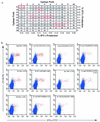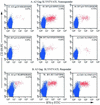Putative immunodominant human immunodeficiency virus-specific CD8(+) T-cell responses cannot be predicted by major histocompatibility complex class I haplotype
- PMID: 10982361
- PMCID: PMC102113
- DOI: 10.1128/jvi.74.19.9144-9151.2000
Putative immunodominant human immunodeficiency virus-specific CD8(+) T-cell responses cannot be predicted by major histocompatibility complex class I haplotype
Abstract
Recent studies of human immunodeficiency virus (HIV)-specific CD8(+) T cells have focused on responses to single, usually HLA-A2-restricted epitopes as surrogate measures of the overall response to HIV. However, the assumption that a response to one epitope is representative of the total response is unconfirmed. Here we assess epitope immunodominance and HIV-specific CD8(+) T-cell response complexity using cytokine flow cytometry to examine CD8(+) T-cell responses in 11 HLA-A2(+) HIV(+) individuals. Initial studies demonstrated that only 4 of 11 patients recognized the putative immunodominant HLA-A2-restricted p17 epitope SLYNTVATL, suggesting that the remaining subjects might lack significant HIV-specific CD8(+) T-cell responses. However, five of six SLYNTVATL nonresponders recognized other HIV epitopes, and two of four SLYNTVATL responders had greater responses to HIV peptides restricted by other class I alleles. In several individuals, no HLA-A2-restricted epitopes were recognized, but CD8(+) T-cell responses were detected to epitopes restricted by other HLA class I alleles. These data indicate that an individual's overall CD8(+) T-cell response to HIV is not adequately represented by the response to a single epitope and that individual major histocompatibility complex class I alleles do not predict an immunodominant response restricted by that allele. Accurate quantification of total HIV-specific CD8(+) T-cell responses will require assessment of the response to all possible epitopes.
Figures




References
-
- Altman J D, Moss P A H, Goulder P J R, Barouch D H, McHeyzer-Williams M G, Bell J I, McMichael A J, Davis M M. Phenotypic analysis of antigen-specific T lymphocytes. Science. 1996;274:94–96. - PubMed
-
- Brander C, Hartman K E, Trocha A K, Jones N G, Johnson R P, Korber B, Wentworth P, Buchbinder S P, Wolinsky S, Walker B D, Kalams S A. Lack of strong immune selection pressure by the immunodominant, HLA- A*0201-restricted cytotoxic T lymphocyte response in chronic human immunodeficiency virus-1 infection. J Clin Investig. 1998;101:2559–2566. - PMC - PubMed
-
- Brander C, Yang O O, Jones N G, Lee Y, Goulder P, Johnson R P, Trocha A, Colbert D, Hay C, Buchbinder S, Bergmann C C, Zweerink H J, Wolinsky S, Blattner W A, Kalams S A, Walker B D. Efficient processing of the immunodominant, HLA-A*0201-restricted human immunodeficiency virus type 1 cytotoxic T-lymphocyte epitope despite multiple variations in the epitope flanking sequences. J Virol. 1999;73:10191–10198. - PMC - PubMed
Publication types
MeSH terms
Substances
Grants and funding
LinkOut - more resources
Full Text Sources
Other Literature Sources
Medical
Research Materials

